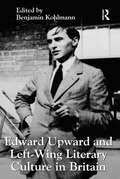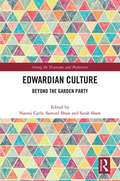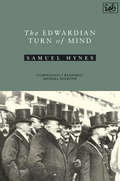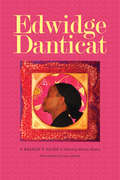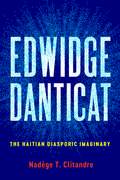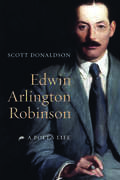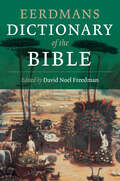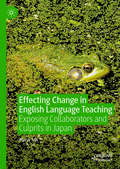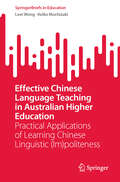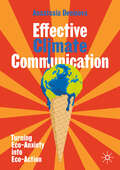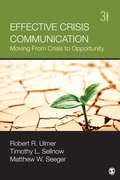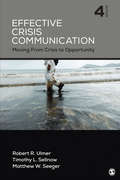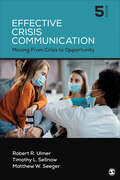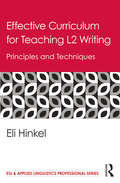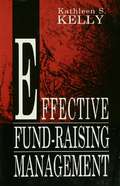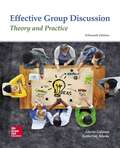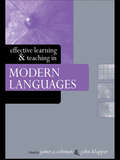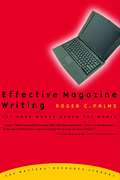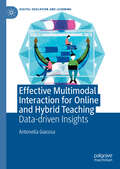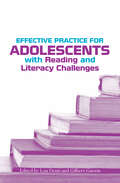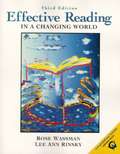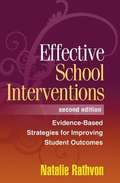- Table View
- List View
Edward Upward and Left-Wing Literary Culture in Britain
by Benjamin KohlmannOffering the first book-length consideration of Edward Upward (1903-2009), one of the major British left-wing writers, this collection positions his life and works in the changing artistic, social and political contexts of the twentieth and early twenty-first centuries. Upward’s fiction and non-fiction, from the 1920s onwards, illustrate the thematic and formal richness of left-wing writing during the twentieth-century age of extremes. At the same time, Upward’s work shows the inherent tensions of a life committed at once to writing and to politics. The full range of Upward’s work and a wealth of unpublished materials are examined, including his early fantastic stories of the 1920s, his Marxist fiction of the 1930s, the extraordinary semi-autobiographical trilogy The Spiral Ascent and his formally and thematically innovative later stories. The essays collected here reevaluate Upward’s central place in twentieth-century British literary culture and assess his legacy for the twenty-first century.
Edwardian Culture: Beyond the Garden Party (Among the Victorians and Modernists)
by Sarah Shaw Samuel Shaw Naomi CarleEdwardian Culture: Beyond the Garden Party is the first truly interdisciplinary collection of essays dealing with culture in Britain c.1895-1914. Bringing together essays on literature, art, politics, religion, architecture, marketing, and imperial history, the study highlights the extent to which the culture and politics of Edwardian period were closely intertwined. The book builds upon recent scholarship that seeks to reclaim the term ‘Edwardian’ from prevalent, restrictive usages by venturing beyond the garden party – and the political rally – to uncover some of the terrain that lies between. The essays in the volume – which deal with both famous writers such as J. M. Barrie and Arnold Bennett, as well as many lesser-known figures – draw attention to the nuanced multiplicity of experience and cultural forms that existed during the period, and highlight the ways in which a closer examination of Edwardian culture complicates our definitions of ‘Victorian’ and ‘Modern’. The book argues that the Edwardian era, rather than constituting a coda to the Victorian period or a languid pause before modernism shook things up, possessed a compelling and creative tenor of its own.
Edwardian Turn Of Mind
by Samuel HynesThe Edwardian Turn of Mind brilliantly evokes the cultural temper of an age. The years between the death of Queen Victoria and the outbreak of the First World War witnessed a turbulent and dramatic struggle between the old and the new. Samuel Hynes considers the principal areas of conflict - politics, science, the arts and the relations between men and women - and fills them with a wide-ranging cast of characters: Tories, Liberals and Socialists, artists and reformers, psychoanalysts and psychic researchers, sexologists, suffragettes and censors. His book is a portrait of a tumultuous time - out of which contemporary England was made.
Edwidge Danticat: A Reader's Guide
by Martin Munro Dany LaferrièreBreath, Eyes, Memory (1994), the novel born from Edwidge Danticat's childhood in Haiti and immigration to New York City, was one of the great literary debuts of recent times, marking the emergence of an impressive talent in addition to opening up an entire culture to a broad general readership. This gifted author went on to win the American Book Award in 1999 for her novel, The Farming of Bones (1998), attracting further critical acclaim. Offering an accessible guide for readers and critics alike, this book is the first publication devoted entirely to Danticat's unique and remarkable work. It is also distinctive in that it addresses all of her published writing up to The Dew Breaker (2004), including her writing for children, her travel writing, her short fiction, and her novels. The book contains an exclusive interview with Danticat, in which she discusses her recent memoir, Brother, I'm Dying (2007), winner of the National Book Critics Circle Award. It also includes an extensive bibliography. With contributions from Danticat's fellow creative writers from both the Caribbean and the United States as well as leading scholars of Caribbean literature, this collection of essays aims to enrich readers' understanding of the various geographical, literary, and cultural contexts of her work and to demonstrate how it both influences and is influenced by them. ContributorsMadison Smartt Bell * Myriam J. A. Chancy * Maryse Condé * J. Michael Dash * Charles Forsdick * Mary Gallagher * Régine Michelle Jean-Charles * Carine Mardorossian * Nadève Ménard * Martin Munro * Nick Nesbitt * Mireille Rosello * Renee H. Shea * Évelyne Trouillot * Lyonel Trouillot * Kiera Vaclavik
Edwidge Danticat: The Haitian Diasporic Imaginary (New World Studies)
by Nadège T. ClitandreHaitian-American writer Edwidge Danticat is one of the most recognized writers today. Her debut novel, Breath, Eyes, Memory, was an Oprah Book Club selection, and works such as Krik? Krak! and Brother, I’m Dying have earned her a MacArthur "genius" grant and National Book Award nominations. Yet despite international acclaim and the relevance of her writings to postcolonial, feminist, Caribbean, African diaspora, Haitian, literary, and global studies, Danticat’s work has not been the subject of a full-length interpretive literary analysis until now. In Edwidge Danticat: The Haitian Diasporic Imaginary, Nadège T. Clitandre offers a comprehensive analysis of Danticat’s exploration of the dialogic relationship between nation and diaspora. Clitandre argues that Danticat—moving between novels, short stories, and essays—articulates a diasporic consciousness that acts as a form of social, political, and cultural transformation at the local and global level. Using the echo trope to approach Danticat’s narratives and subjects, Clitandre effectively navigates between the reality of diaspora and imaginative opportunities that diasporas produce. Ultimately, Clitandre calls for a reconstitution of nation through a diasporic imaginary that informs the way people who have experienced displacement view the world and imagine a more diverse, interconnected, and just future.
Edwin Arlington Robinson: A Poet's Life
by Scott DonaldsonThe first full-scale biography of a great American poet written by a leading literary biographer.
Edwin Arlington Robinson: A Poet's Life
by Scott DonaldsonAt the time of his death in 1935, Edwin Arlington Robinson was regarded as the leading American poet-the equal of Frost and Stevens. In this biography, Scott Donaldson tells the intriguing story of this poet's life, based in large part on a previously unavailable trove of more than 3,000 personal letters, and recounts his profoundly important role in the development of modern American literature. Born in 1869, the youngest son of a well-to-do family in Gardiner, Maine, Robinson had two brothers: Dean, a doctor who became a drug addict, and Herman, an alcoholic who squandered the family fortune. Robinson never married, but he fell in love as many as three times, most lastingly with the woman who would become his brother Herman's wife. Despite his shyness, Robinson made many close friends, and he repeatedly went out of his way to give them his support and encouragement. Still, it was always poetry that drove him. He regarded writing poems as nothing less than his calling-what he had been put on earth to do. Struggling through long years of poverty and neglect, he achieved a voice and a subject matter all his own. He was the first to write about ordinary people and events-an honest butcher consumed by grief, a miser with "eyes like little dollars in the dark," ancient clerks in a dry goods store measuring out their days like bolts of cloth. In simple yet powerful rhetoric, he explored the interior worlds of the people around him. Robinson was a major poet and a pivotal figure in the course of modern American literature, yet over the years his reputation has declined. With his biography, Donaldson returns this remarkable talent to the pantheon of great American poets and sheds new light on his enduring legacy.
Eerdmans Dictionary of the Bible
by David Noel FreedmanThe Eerdmans Dictionary of the Bible gathers nearly 5,000 alphabetically ordered articles that thoroughly yet clearly explain all the books, persons, places, and significant terms found in the Bible. The Dictionary also explores the background of each biblical book and related writings and discusses cultural, natural, geographical, and literary phenomena--matters that Bible students at all levels may encounter in reading or discussion. Nearly 600 first-rate Bible authorities have contributed to the Eerdmans Dictionary of the Bible. Intended as a tool for practical Bible use, this illustrated dictionary reflects recent archaeological discoveries and the breadth of current biblical scholarship, including insights from critical analysis of literary, historical, sociological, and other methodological issues. The editorial team has also incorporated articles that explore and interpret important focuses of biblical theology, text and transmission, Near Eastern archaeology, extrabiblical writings, and pertinent ecclesiastical traditions--all of which help make the Eerdmans Dictionary of the Bible the most comprehensive and up-to-date one-volume Bible dictionary on the market today.
Effecting Change in English Language Teaching: Exposing Collaborators and Culprits in Japan
by Glenn TohThis book is about the challenges that come with initiatives to develop a more humanized, intersectional and negotiable landscape for English Language Teaching (ELT). It sets out to problematize ingrown and ingrained practices in English teaching, weaving together obscured practices, undisclosed agendas and ideologically motivated (inter)actions to expose the unspoken agendas at work. Drawing on his own experience of being part of an English as a Lingua Franca (ELF) programme at an urban Japanese university, the author presents a case for rethinking language education in Japan. This book will be of interest to applied linguists, language teachers and teacher trainers, cultural anthropologists, and anyone interested in the cultural politics of education, especially language education.
Effective Chinese Language Teaching in Australian Higher Education: Practical Applications of Learning Chinese Linguistic (Im)politeness (SpringerBriefs in Education)
by Keiko Mochizuki Leei WongThis book focuses on teaching and learning Chinese linguistic (im)politeness and bridges the gap between research on Chinese linguistic (im)politeness and the context of teaching Chinese as an international language. Specifically, it investigates the pragmatics of (im)politeness, focusing on how (im)politeness is presented in current textbooks, and includes a comparative analysis of the treatment and explanation of (im)politeness and politeness strategies within these textbooks. Additionally, the various chapters examine instructors&’ and lecturers&’ perceptions of teaching and learning linguistic (im)politeness. By filling in a research gap in the teaching and learning of Chinese linguistic (im)politeness, this book provides valuable insights and perspectives on the practical applications of politeness strategies in additional language teaching.
Effective Climate Communication: Turning Eco-Anxiety into Eco-Action
by Anastasia DenisovaThis book explores the urgent challenges of communicating climate change in the media. While many books have been written about climate change, this book goes to the very heart of what makes humans care about stories enough to act. In a direct and sympathetic approach, Denisova tackles problems of greenwashing, news narratives, colonial framings and more. Taking climate anxiety as a starting point, the author positions herself with empathy and asks the question: ‘what slows down citizen action?’ This fresh perspective acknowledges the pressing challenge of public disengagement and the anxiety people feel when faced with increasingly bleak headlines as the climate crisis intensifies. There is a surprising challenge to apocalyptic storytelling and a hero’s narrative, which Denisova argues are counter-productive, while solutions are provided for media storytellers. This book is essential reading for anyone seeking to ease climate-related anxiety and foster a deeper sense of empowerment in their audience.
Effective Crisis Communication: Moving From Crisis to Opportunity
by Matthew W. Seeger Dr Robert R. Ulmer Dr Timothy L. SellnowIn this fully updated Third Edition, three of today’s most respected crisis/risk communication scholars provide the latest theory, practice, and innovative approaches for handling crisis. This acclaimed book presents a clear understanding about how to manage risks and crises effectively. The authors provide 18 in-depth case studies that highlight successes and failures in dealing with core issues of crisis leadership, managing uncertainty, communicating effectively, understanding risk, promoting communication ethics, enabling organizational learning, and producing renewing responses to crisis. Unlike other crisis communication texts, this book answers the question, “What now?” and explains how organizations can and should emerge from crisis. Authors Robert R. Ulmer, Timothy L. Sellnow, and Matthew W. Seeger provide guidelines for taking the many challenges that crises present and turning those challenges into opportunities.
Effective Crisis Communication: Moving From Crisis to Opportunity
by Matthew W. Seeger Dr Robert R. Ulmer Dr Timothy L. SellnowIn this fully updated Fourth Edition of Effective Crisis Communication, three of today’s most respected crisis/risk communication scholars provide the latest theories and innovative approaches for handling crisis. Unlike other crisis communication texts, this acclaimed book answers the question, “what now?” and explains how organizations can create the potential for opportunity, renewal, and growth through effective crisis communication. Authors Robert R. Ulmer, Timothy L. Sellnow, and Matthew W. Seeger provide guidelines for taking the many challenges that crises present and turning those challenges into opportunities. Practical lessons and in-depth case studies highlight successes and failures in dealing with core issues of crisis leadership, including managing uncertainty, communicating effectively, understanding risk, promoting communication ethics, enabling organizational learning, and producing renewing responses to crisis. New to the Fourth Edition: New and updated examples and case studies include diverse cases from recent headlines such as SeaWorld’s reaction to Blackfish, the United Airlines debacle, and the Flint Water Crisis. Updated theories and references throughout provide you with the latest information for effective crisis communication.
Effective Crisis Communication: Moving From Crisis to Opportunity
by Matthew W. Seeger Dr Robert R. Ulmer Dr Timothy L. SellnowIn this fully updated Fourth Edition of Effective Crisis Communication, three of today’s most respected crisis/risk communication scholars provide the latest theories and innovative approaches for handling crisis. Unlike other crisis communication texts, this acclaimed book answers the question, “what now?” and explains how organizations can create the potential for opportunity, renewal, and growth through effective crisis communication. Authors Robert R. Ulmer, Timothy L. Sellnow, and Matthew W. Seeger provide guidelines for taking the many challenges that crises present and turning those challenges into opportunities. Practical lessons and in-depth case studies highlight successes and failures in dealing with core issues of crisis leadership, including managing uncertainty, communicating effectively, understanding risk, promoting communication ethics, enabling organizational learning, and producing renewing responses to crisis. New to the Fourth Edition: New and updated examples and case studies include diverse cases from recent headlines such as SeaWorld’s reaction to Blackfish, the United Airlines debacle, and the Flint Water Crisis. Updated theories and references throughout provide you with the latest information for effective crisis communication.
Effective Crisis Communication: Moving From Crisis to Opportunity
by Robert R. Ulmer Matthew W. Seeger Timothy L. SellnowIn this fully updated Fifth Edition, three of today’s most respected crisis/risk communication scholars provide the latest theory, practice, and innovative approaches for handling crisis. This acclaimed book presents the discourse of renewal as a theory to manage crises effectively. The book provides in-depth case studies that highlight successes and failures in dealing with core issues of crisis leadership, managing uncertainty, communicating effectively, understanding risk, promoting communication ethics, enabling organizational learning, and producing renewing responses to crisis. Unlike other crisis communication texts, this book answers the question, "What now?" and explains how organizations can and should emerge from crisis. Authors Robert R. Ulmer, Timothy L. Sellnow, and Matthew W. Seeger provide guidelines for taking the many challenges that crises present and turning those challenges into opportunities for overcoming a crisis.
Effective Crisis Communication: Moving From Crisis to Opportunity
by Robert R. Ulmer Matthew W. Seeger Timothy L. SellnowIn this fully updated Fifth Edition, three of today’s most respected crisis/risk communication scholars provide the latest theory, practice, and innovative approaches for handling crisis. This acclaimed book presents the discourse of renewal as a theory to manage crises effectively. The book provides in-depth case studies that highlight successes and failures in dealing with core issues of crisis leadership, managing uncertainty, communicating effectively, understanding risk, promoting communication ethics, enabling organizational learning, and producing renewing responses to crisis. Unlike other crisis communication texts, this book answers the question, "What now?" and explains how organizations can and should emerge from crisis. Authors Robert R. Ulmer, Timothy L. Sellnow, and Matthew W. Seeger provide guidelines for taking the many challenges that crises present and turning those challenges into opportunities for overcoming a crisis.
Effective Curriculum for Teaching L2 Writing: Principles and Techniques (ESL & Applied Linguistics Professional Series)
by Eli HinkelEffective Curriculum for Teaching L2 Writing sets out a clear big picture for curricular thinking about L2 writing pedagogy and offers a step-by-step guide to curriculum design with practical examples and illustrations. Its main purpose is to help pre-service and practicing teachers design courses for teaching academic writing and to do this as efficiently and effectively as possible. Bringing together the what and the how-to with research-based principles, what sets this book apart is its overarching focus on language pedagogy and language building. Part 1 examines curricular foundations in general and focuses on what is socially valued in L2 writing and pedagogy at school and at the college and university level. Part 2 is concerned with the nitty-gritty̶—the daily realities of curricular design and classroom instruction. Part 3 takes a close look at the key pedagogical ingredients of teaching academic L2 writing: vocabulary and collocations, grammar for academic writing, and down-to-earth techniques for helping L2 writers to organize discourse and ideas. The Appendix provides an extensive checklist for developing curricula for a course or several courses in language teaching.
Effective Fund-Raising Management (Routledge Communication Series)
by Kathleen S. KellyIn a ground-breaking departure from existing works, almost all of which are how-to manuals based on anecdotal evidence, this is the first academic textbook on fund raising. By integrating practical knowledge with social science theory and research, it presents a comprehensive approach to the function, from its legal and ethical principles to the managerial process by which gifts are raised. Territory previously uncharted in the literature is explored, such as the historical and organizational contexts of contemporary practice. Explanations of programs, techniques, and publics introduce a new system for understanding fund raising's major concepts. Unlike efforts in established fields, most of the material represents original scholarship undertaken to produce a first-time text. The book's main purpose is to teach students about fund raising--a high-demand, high-paying occupation that will continue to expand into the 21st century as the need for trained practitioners exceeds the supply. During the last decade, fund-raising education moved into the formal classroom and away from an apprenticeship tradition of senior practitioners mentoring newcomers. Yet until now, there has not been a textbook to support this evolving professionalism. Faculty have been reluctant to define fund raising as an academic subject in the absence of a theory-based teaching resource, and courses usually have been assigned to part-time instructors hired from the practice. This textbook addresses the void. It is designed for graduate and upper-level undergraduate courses dealing with fund raising as a primary or secondary subject. Among its features, each chapter points out research gaps and opportunities--such as problems and theories for master's theses and doctoral dissertations--and ends with a list of suggested readings. The text is appropriate for the diverse academic areas in which fund raising, nonprofit management, and philanthropy are taught, including public administration, management, arts and humanities, education, social work, economics, and sociology. Because of its public relations orientation, it is particularly suited for courses offered in that discipline. Additional audiences are practitioners enrolled in professional development programs; CEOs, trustees, and others interested in self-study; and scholars who need serious literature on the subject.PROFESSIONAL PROMO PIECE COPY..............Recently, the field of fundraising seems to have taken a giant step backward. Rather than conducting principled efforts to support common political, educational, financial, or social causes, the entire process is making headlines as a venue offering opportunities for influence peddling, corruption and self-promotion. The need for a guide to ethical fund-raising management is greater than ever. Effective Fund-Raising Management addresses this need.The most successful fundraisers understand why certain practices are more effective than others. What works in one situation may not work in another similar--but slightly different--situation. That is why theoretical understanding is vital to fundraising professionals. To be an expert practitioner, one must have have enough theoretical understanding to adapt one's practice to a variety of situations. That is the purpose of Effective Fund-Raising Management--to provide the underlying theoretical and conceptual understandings that enable an effective practitioner to become an expert practitioner.Indispensable to fund-raising professionals, this invaluable resource: * reviews the entire scope of the fund-raising profession-- from its historical antecedents to the current legal, ethical, organizational, and theoretical principles underlying its practice today;* provides concise definitions and explanations of the fund-raising process and its position within the field of public relations;* links effective fund-raising practices to ethical considerations; and * examines four of the major methods of fund raising-- annual giving, major gifts, planned giving, and capital campaigns.
Effective Group Discussion: Theory and Practice
by Katherine L. Adams Gloria J. GalanesNow in its fifteenth successful edition, Effective Group Discussion combines the most recent research findings and practical tools students need to become productive group members. A variety of secondary groups are covered in the text: work groups, committees, task forces, self-directed work teams, and other small groups whose objectives include finding solutions to problems, producing goods, and creating policies.
Effective Learning and Teaching in Modern Languages (Effective Learning and Teaching in Higher Education)
by John Klapper James A. ColemanEffective Learning and Teaching in Modern Languages offers insights from the latest research into learning and teaching a language, and also outlines innovative teaching techniques, covering all the critical subjects including: the demands made of students and staff in modern languages the four language skills assessment, grammar, vocabulary and translation technology-enhanced learning residence abroad subdisciplines such as business, area, cultural and literary studies, and linguistics professional development. Providing both a clear overview of the discipline and a wealth of techniques, practical advice and useful resources, this book will be welcomed by lecturers or tutors new to the profession and experienced lecturers wanting to keep up with the latest developments and improve their students' learning.
Effective Magazine Writing: Let Your Words Reach the World
by Roger PalmsLet your words reach the WorldIf you are a writer who wants to have an impact with your words in the Christian magazine market, this book is for you. The former editor of Decision magazine, Palms helps you take stock of your gifts and use the to creatively minister to others. Giving a clear understanding of each step in the magazine process, Palm describes how to work with editors, write a query letter, and conduct interviews. He demonstrates how to find ideas, develop each draft, and overcome problems with grammar, tenses, story line, and voice. The book also addresses the ethical and legal side of writing, as well as understanding the diversity of readers in our every-changing culture.From the Trade Paperback edition.
Effective Multimodal Interaction for Online and Hybrid Teaching: Data-driven Insights (Digital Education and Learning)
by Antonella GiacosaThis book provides educators (including but not limited to those at university level) with data-driven insights into video-mediated interaction. Drawing on extensive research on classroom interaction from a variety of theoretical and analytical perspectives, including four years of observing online university courses that began during the Covid-19 pandemic, the author provides deep insights into video-mediated interaction by comparing direct classroom observations with data provided by teachers and students via online questionnaires. The book clarifies how the newly experienced classroom contexts differ from traditional online and blended classes, then draws on the extensive experience of video-mediated instruction in terms of teacher-learner, learner-content, and learner-learner interaction to decipher what can be challenging and promising about interacting via a screen, specifically addressing multimodal interaction. It also provides practitioners with data-driven suggestions from the perspective of teachers and learners for improving teaching and learning in modern video-based educational contexts that are consistently different from the pre-pandemic idea of e-learning. This book will be a valuable resource for researchers in Applied Linguistics, Language Education and Higher Education more broadly, teachers in higher education institutions worldwide, and teacher education and training and institutional bodies responsible for improving teaching facilities.
Effective Practice for Adolescents with Reading and Literacy Challenges
by Lou Denti Gilbert GuerinLack of reading proficiency is a barrier to understanding the academic content of any discipline. Effective Practice for Adolescents with Reading and Literacy Challenges provides secondary teachers with the knowledge and the strategies they need to improve their students' reading skills. Editors Denti and Guerin present a comprehensive collection of articles by a selection of prominent literacy and education researchers that provide practical approaches to improving literacy and offer accounts of successful evidence-based programs and practices that can be tailored to the needs of teachers working with struggling readers. Each chapter includes questions for review, a list of web resources, and suggested small group activities to encourage implementation of chapter ideas and strategies, making Effective Practice for Adolescents with Reading and Literacy Challenges a valuable tool for all teachers, regardless of content area.
Effective Reading in a Changing World 3rd Edition
by Rose Wassman Lee Ann RinskySelected writings (essays, textbooks, and fiction)from a diverse group of award-winning journalists and authors.
Effective School Interventions, Second Edition
by Natalie Rathvon Paula FreerThis highly practical resource and text presents 70 interventions that have been demonstrated to improve the classroom learning environment, academic achievement, and student behavior and social competence. Each intervention is presented in a brief, standardized format with step-by-step procedures that can easily be implemented by Pre-K-12 teachers and other school-based professionals. The volume includes best-practice guidelines for designing, implementing, and evaluating evidence-based school interventions, as well as strategies for combining multiple interventions to create a comprehensive program at the individual, class, or school wide level. New to This Edition Substantially revised and expanded to reflect significant developments in research and practice. Designed for full compatibility with a response-to-intervention framework.42 of the 70 interventions are entirely new. More in-depth discussions of intervention procedures facilitate implementing and adapting the techniques. A new chapter on preschool interventions. Expanded coverage of curriculum-based measurement procedures. A new category of proactive interventions targeting positive relationships in the classroom.
